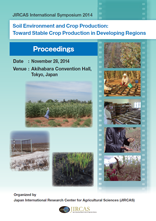Soil Salinization and Its Mechanism in Checkdam Farmlands in the Loess Plateau, China

The Loess Plateau is located in middle reaches of the Yellow River in China and facing a serious
problem of water erosion. Construction of a check-dam system is one of the most effective measures to
conserve soil and water. Primary functions of a check-dam are gully control, flood control and water
storage. After the reservoir is filled with sediment and flat land is formed and utilized as a farmland.
However soil salinization is observed in check-dam farmlands in some watersheds. Therefore, the
author studied on the present status of soil salinization in the farmland and the affecting factors. Xiao
He Gou watershed is selected as a study area since the soil salinization occurs in a system scale, and
intensive field investigation on status of soil salinization and continuous monitoring of groundwater
level in the farmland is conducted in Cao Mao dam farmland. The status of soil salinization is assessed
with electric conductivity, pH and sodium absorption ratio. Grain size analysis and measurement of
groundwater level are also conducted in order to clarify the relationship among soil texture,
groundwater level and soil salinization.
ECe was lower than 3 dS/m in the lower part(from dam body to 1.6 km upstream) of the farmland
while it was higher than 3 dS/m in the upper part(from 1.6 km to 2.0 km upstream) of the farmland.
Grain size analysis indicated that soil is sandy and there is not apparent difference of soil type in terms
of spatial and vertical distribution. Groundwater level in the farmland is higer in the upper part than
the lower part. Seasonal fluctuation of groundwater level is observed. The range of groundwater level
fluctuation is about 1.0 meter through a year and the groundwater level gradually decreases from sping
to autumun except heavy rainfall events and slowly increases during winter without any heavy rainfall
events. It is suggested that increase of groundwater level in winter is caused by the frozen soil at least
70 cm from the soil surface and this block the groundwater flow and then the groundwater level
decreases in spring when the frozen soil melts. The field surveys at Cao Mao dam farmland indicated
that soil salinization is mainly caused by groundwater level rather than soil texture in the farmland.
It is essential to control groundwater level by reducing inflow from upstream dams and the side
slope, and improving drainage function in the farmland in order to prevent soil salinization.
| Date of issued | |
|---|---|
| Creator | Katsuyuki Shimizu |
| Subject |
Salinity Groundwater Rain-fed agriculture Semi arid land |
| Publisher | Japan International Research Center for Agricultural Sciences |
| Available Online | |
| Issue | 2014 |
| spage | 132 |
| epage | 140 |
| Rights | Japan International Research Center for Agricultural Sciences |
| Language | eng |
